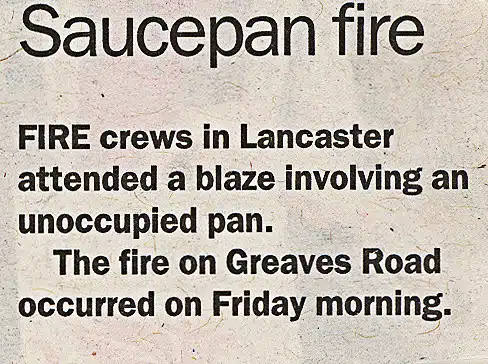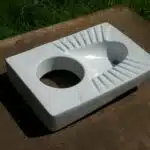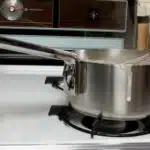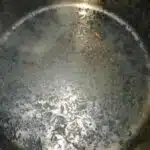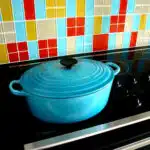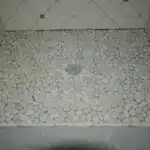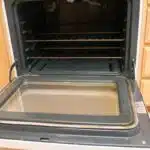Burnt pans are a common problem in every household. Most of us have experienced the frustration of trying to remove burnt-on food from a pan. Burnt pans not only look unsightly but they can also be difficult to clean, and if left uncleaned, they can leave a bad taste in your mouth. However, with the right tools and methods, cleaning burnt pans can be easy and stress-free.
In this article, we will discuss seven easy methods for cleaning burnt pans. These methods have been tried and tested by professional home cleaning experts and are guaranteed to make your life easier. Whether you have burnt-on food on your stainless steel pan or enamel-coated pot, these methods will help you get rid of the stubborn stains without damaging your cookware. So sit back, relax and learn how to clean your burnt pans like a pro!
Soaking With Baking Soda And Vinegar
Chances are, you’ve encountered a burnt pan before. It’s frustrating to see your favorite cookware stained with stubborn grease and food residue. Fortunately, there are natural cleaning solutions that can help make cleaning easier and more efficient. One of the most popular methods is soaking the pan with baking soda and vinegar.
Baking soda benefits are well-known in the cleaning industry, thanks to its abrasive nature that allows it to cut through grime and dirt. When combined with vinegar, another household staple for cleaning purposes, it creates a powerful solution that can dissolve even the toughest stains. This combination works by creating a chemical reaction that releases carbon dioxide, which helps loosen up debris on the surface of your pan.
To use this method, start by filling your burnt pan with hot water until it covers the burnt area. Add a cup of baking soda and let it sit for about 30 minutes. Afterward, pour in a cup of vinegar and let it fizz for a few minutes before discarding the liquid and scrubbing the pan gently with a non-abrasive sponge or brush.
By using natural cleaning solutions like baking soda and vinegar, you’re not only saving money but also reducing your exposure to harsh chemicals found in commercial cleaning products. If soaking with baking soda and vinegar doesn’t work for you, don’t worry – there are other methods to try out! Another effective technique is boiling water – read on to learn how to do it right.
Boiling Water Method
Boiling water is an effective method to clean burnt pans. The high temperature of boiling water can help loosen the burnt food particles from the surface of the pan, making them easier to remove. This method is also relatively simple and requires only a few steps.
To use boiling water for cleaning burnt pans, start by filling the pan with enough water to cover the burnt area. Then, bring the water to a boil and let it simmer for about 10-15 minutes. After this time, turn off the heat and allow the water to cool down before discarding it.
Preventing burns is important when using this method. Always use oven mitts or pot holders when handling hot pans or boiling water. Also, be careful not to splash yourself with hot liquid while pouring out the water from the pan.
If boiling water does not work for your particular pan or if you are looking for alternatives, there are other methods that you can try. Some people find success with soaking their pans in a mixture of warm water and baking soda overnight. Others prefer using vinegar or dish soap to help break down stubborn grime. Experimenting with different methods may help you find what works best for your specific situation.
Transition: While boiling water can be a helpful tool in cleaning burnt pans, sometimes more intense scrubbing is necessary. In the next section, we will discuss how salt and lemon can be used together as a powerful cleaning agent for tough stains.
Scrubbing With Salt And Lemon
One technique that can help remove stubborn burnt stains on pans is scrubbing with salt and lemon. This method involves the use of natural cleaners, which have several benefits over chemical cleaners. For one, they are non-toxic and safe to use around children and pets. Additionally, natural cleaners are more eco-friendly since they do not contain harsh chemicals that can harm the environment.
To start, sprinkle a generous amount of salt on the burnt pan and add some lemon juice. Let it sit for a few minutes before using a scouring pad or brush to scrub it clean. If you don’t have fresh lemons, you can also use lemon essential oil or vinegar as alternatives for cleaning. Lemon has natural acidic properties that break down tough stains while leaving a fresh scent.
Overall, scrubbing with salt and lemon is an effective way to clean burnt pans without relying on harsh chemicals. However, if you find that this method does not work for your particular pan or stain, you may need to consider using a commercial cleaner. In the next section, we will explore how to safely use these types of cleaners to get your pans looking like new again.
Using A Commercial Cleaner
When it comes to choosing a commercial cleaner to clean burnt pans, it is important to consider the type of material used in the pan, as some cleaners can be too abrasive for certain materials. It is also important to read the instructions on the cleaner to determine how it should be applied to the pan. Generally, the cleaner should be applied to a damp cloth or sponge and then applied to the pan in a circular motion. After the cleaner has been applied, it should be left to sit for the time recommended by the manufacturer before being wiped off with a damp cloth.
Choosing A Cleaner
When it comes to using a commercial cleaner for burnt pans, choosing the right type of cleaner is crucial. There are many options available in the market that promise to clean your pan effortlessly, but not all cleaners are created equal. So, how do you choose the right one? Firstly, consider the type of pan you have and its coating. Non-stick pans require gentle cleaners that won’t damage the coating, whereas stainless steel pans can withstand harsher cleaners. Secondly, check the label for any warnings or precautions before purchasing a cleaner.
If you’re concerned about the environment and want to use eco-friendly options for burnt pan cleaning, there are many products available that are safe for both your pan and the planet. Look for cleaners that contain natural ingredients such as baking soda, vinegar, or lemon juice. These ingredients work wonders on burnt pans without leaving any harmful residue behind. You can also try using a paste made from baking soda and water to scrub off stubborn stains.
In conclusion, choosing the right cleaner is essential for effective burnt pan cleaning. Consider your pan’s material and coating before selecting a product. If you prefer eco-friendly options, look for cleaners with natural ingredients such as baking soda or vinegar. With these tips in mind, you’ll be able to choose a suitable cleaner that will leave your burnt pan looking like new again!
Applying A Cleaner
After carefully selecting the right cleaner for your burnt pan, the next step is to apply it correctly. Applying a cleaner properly can make all the difference in how effectively it removes stains and grime from your pan. Start by reading the instructions on the label carefully, as each cleaner may have specific directions for use. It’s also essential to wear gloves and protect your skin while cleaning.
When applying a commercial cleaner, start by adding a small amount to the pan and spreading it evenly with a sponge or brush. Let the cleaner sit for a few minutes before scrubbing gently with a non-abrasive pad. Avoid using steel wool or any harsh scrubbers that may damage the pan’s surface. For stubborn stains, you may need to repeat this process several times until they disappear entirely.
If you’re using an eco-friendly cleaner, follow similar steps but be mindful of its natural ingredients. Apply enough paste or solution to cover the stain and let it sit for several minutes before scrubbing gently with a non-abrasive pad or brush. The benefits of using eco-friendly cleaners are not only safer for your health but also better for the environment. They are free of toxic chemicals that may harm aquatic life when disposed of improperly, making them a great alternative to traditional cleaners.
In summary, applying a commercial cleaner correctly is crucial for restoring your burnt pans’ appearance and extending their lifespan. Always read the instructions on the label carefully and wear protective gear when necessary. Whether you choose traditional or eco-friendly cleaners, remember to select one that matches your pan’s material and coating type for optimal results.
Applying Dish Soap And Water
Commercial cleaners can be effective in removing burnt food residue from pans. However, they often contain harsh chemicals that can be harmful to the environment and your health. Additionally, using a commercial cleaner every time you have a burnt pan is not always practical or cost-effective. Therefore, it is important to know other methods of cleaning burnt pans.
One of the most effective ways to clean burnt pans is by scrubbing them with dish soap and water. This method is affordable, easy to do, and does not require any special equipment or cleaning products. To start, fill the burnt pan with hot water and add a few drops of dish soap. Let it soak for about 10-15 minutes before scrubbing it with a non-abrasive sponge or brush. Rinse the pan thoroughly with hot water and dry it immediately.
The benefits of scrubbing your burnt pan are twofold: first, it helps remove any stuck-on food particles that can cause future burns; second, it prevents the formation of rust or corrosion on the surface of your pan. To prevent burns in the future, make sure you use an appropriate cooking temperature for your food and avoid leaving it unattended for too long. If you must step away from the stove, set a timer as a reminder to check on your food periodically. By following these tips, you can save yourself time and money while keeping your kitchenware in good condition for years to come.
Utilizing Cream Of Tartar
Cream of tartar is an effective ingredient that can be used to clean burnt pans. It is a white, powdery substance that is made from tartaric acid. Cream of tartar has many benefits when used as a cleaning agent. Not only is it affordable and readily available, but it is also non-toxic and safe for use on cookware.
Benefits of using cream of tartar include:
- It is a natural abrasive that gently removes stubborn stains without scratching the surface of the pan.
- Cream of tartar can help to remove discoloration caused by burnt food or grease.
- It can also be used to remove rust stains from stainless steel pans.
Cream of tartar alternatives include baking soda and vinegar, which are also effective for cleaning burnt pans. However, cream of tartar has a distinct advantage over these alternatives because it does not leave behind any residue or odor.
To use cream of tartar for cleaning burnt pans, first sprinkle a generous amount onto the surface of the pan. Next, add enough water to create a paste and rub it into the stain with a sponge or cloth. Let the paste sit for 15-20 minutes before rinsing off with warm water.
By using cream of tartar to clean your burnt pans, you can save money on expensive cleaning products while achieving excellent results. In the next section, we will discuss another method for cleaning burnt pans – trying the dryer sheet trick.
Trying The Dryer Sheet Trick
- Before attempting the dryer sheet trick for cleaning burnt pans, be sure to have all necessary supplies close at hand, such as dryer sheets, a scrubber, and a sink full of hot, soapy water.
- To use the dryer sheet trick, simply apply a dryer sheet to the soiled area and rub gently.
- With continued rubbing, the burnt material should begin to loosen and come off the pan.
- It may be necessary to apply additional dryer sheets and repeat the process if the first dryer sheet does not fully remove the burnt material.
Gather Supplies
To effectively clean a burnt pan using the dryer sheet trick, you need to gather the necessary supplies. The first item you’ll need is a used or new dryer sheet. You can find these in your laundry room or purchase them from any grocery store. Make sure to choose a scented one for added freshness. Next, grab a pair of rubber gloves to protect your hands from any harsh chemicals that may be used during cleaning.
In addition, you’ll need a sponge or scouring pad and some dish soap. These items can be found in any supermarket or online store. Opt for a heavy-duty sponge that can easily remove tough stains without damaging the surface of the pan. Lastly, make sure to have access to hot water, either from your tap or by heating it up on the stove.
By gathering these supplies beforehand, you’ll be able to effectively clean your burnt pan with ease using the dryer sheet method. With just a few simple steps and minimal effort, you’ll have a shiny and spotless pan in no time!
Apply Dryer Sheet
Now that we have gathered all the necessary supplies, it’s time to try out the dryer sheet trick. This method is considered one of the most effective alternative uses of a dryer sheet in cleaning burnt pans. It not only saves you money, but it also reduces your environmental impact by using fewer chemicals and cleaning agents.
To apply this trick, start by filling the burnt pan with hot water until the bottom is covered. Then, add a few drops of dish soap and place a used or new dryer sheet on top of the water. Let it soak for at least an hour to allow the ingredients to work their magic. Afterward, remove the dryer sheet and use a sponge or scouring pad to scrub away any remaining stains.
The result will be a clean and shiny pan without any harsh chemicals or complicated cleaning procedures. The dryer sheet trick is an excellent solution for those who are looking for an eco-friendly and budget-friendly way to clean their burnt pans while still achieving excellent results. Try it out for yourself and see how easy it is!
Using Bar Keepers Friend
Bar Keepers Friend is a versatile and effective cleaning solution for removing burnt-on food and stains from pans. Its unique formula contains oxalic acid, which works to dissolve tough stains without damaging the surface of your cookware. The benefits of Bar Keepers Friend for cleaning burnt pans are numerous, making it a go-to choice for many home cleaning experts.
When using Bar Keepers Friend on cookware, it’s important to follow some tips for safe use. Firstly, always read the instructions carefully before use and wear gloves to protect your hands. Secondly, avoid using Bar Keepers Friend on non-stick or Teflon-coated surfaces as it can damage them. Thirdly, rinse the pan thoroughly with water after use to remove any residual cleaner.
In summary, Bar Keepers Friend is an effective and safe option for cleaning burnt pans. By following the tips above for safe use and handling, you can effectively remove stubborn stains and restore your cookware to its former glory. In the next section, we will discuss another method for cleaning burnt pans by applying hydrogen peroxide and baking soda.
Applying Hydrogen Peroxide And Baking Soda
Using Bar Keepers Friend is an effective way of removing burnt-on food from pans. However, if you’re looking for alternatives, there are other methods that can be just as effective. One such alternative is using hydrogen peroxide and baking soda.
Hydrogen peroxide is a powerful cleaning agent that can help remove stubborn stains and burnt-on food from pans. Its benefits for cleaning include its ability to break down organic matter and its natural disinfecting properties. When combined with baking soda, it forms a paste that can be applied directly to the pan and left to sit for a few hours before scrubbing away the burnt-on food.
If you don’t have baking soda on hand, there are other alternatives you can use to clean your burnt pans. For example, white vinegar is another excellent cleaning agent that can help loosen up burnt-on food. Simply heat up some white vinegar in the pan until it starts to steam, then let it cool down before scrubbing away any remaining residue.
When it comes to scrubbing away burnt-on food from pans, steel wool is often the go-to tool. However, it’s important to use caution when using steel wool as it can scratch certain types of cookware. Instead, consider using a non-abrasive scrubber or even a ball of aluminum foil for gentler yet effective scrubbing power.
Scrubbing With Steel Wool
When it comes to cleaning burnt pans, using steel wool is one of the most effective methods. However, if not used correctly, it can scratch and damage your pan’s surface. Luckily, there are alternatives to steel wool that you can use to protect your pan from scratches.
One of the best alternatives to steel wool is a nylon scrubber. These scrubbers are gentle on your pan’s surface and can effectively remove any burnt food residue. Another alternative is a baking soda paste made by mixing baking soda and water into a thick consistency. Apply the paste onto your pan’s surface and let it sit for about 10-15 minutes before scrubbing with a non-abrasive sponge.
To prevent scratches on your pans when using steel wool or any other scrubber, always start by soaking your pan in hot water and dish soap for at least 10-15 minutes. This will help loosen any burnt-on food residues and make them easier to remove without damaging your pan’s surface. Be sure to also avoid using abrasive cleaners or harsh chemicals that can damage your pan.
Transition: Now that you know how to scrub burnt pans effectively while preventing scratches, let’s move on to another method: using a magic eraser.
Using A Magic Eraser
Another option for cleaning burnt pans is to use a Magic Eraser. These handy cleaning tools are made of melamine foam and work by using tiny abrasive particles to remove tough stains. However, there are also Magic Eraser alternatives available that work just as well without the high cost.
To use a Magic Eraser, simply wet it with water and gently scrub the burnt areas of your pan. The abrasive particles will break down the burnt food and lift it from the surface, leaving your pan looking clean and shiny once again. This method is especially useful for non-stick pans, as it won’t damage the coating.
If you prefer to clean tough stains without chemicals, you can try using a mixture of baking soda and vinegar instead. Simply sprinkle some baking soda over the burnt areas of your pan, then pour vinegar over the top until it begins to fizz. Let this sit for a few minutes before scrubbing with a non-abrasive sponge or cloth. This method is effective at removing even the toughest stains, without leaving any harsh chemical residue behind.
Next up is trying out the coca-cola method for cleaning burnt pans. While it may sound strange, many people swear by this technique for lifting stubborn stains from their cookware. Keep reading to learn how to try this unconventional method for yourself!
Trying The Coca-Cola Method
Exploring alternatives to traditional cleaning methods can be a fun and exciting endeavor. One such alternative that has gained popularity in recent years is the use of Coca-Cola to clean burnt pans. This method involves pouring a can of Coca-Cola into a pan that has been burnt, letting it soak for several hours, and then scrubbing away the grime.
Many people swear by the effectiveness of this method, claiming that it works wonders on even the most stubborn stains. The acidity of Coca-Cola is said to break down the burnt-on food particles, making them easier to remove. Additionally, the carbonation in the soda creates bubbles that help to lift away any remaining debris.
While there are certainly skeptics who doubt the efficacy of this method, it is worth giving it a try if you have a particularly tough pan to clean. Just be sure to use enough soda – at least one full can per pan – and give it plenty of time to work its magic. With a little patience and elbow grease, you may just find that Coca-Cola is your new go-to cleaning solution for burnt pans.
Transitioning into applying ammonia without using ‘step’, another alternative method for cleaning burnt pans involves using household ammonia.
Applying Ammonia
Applying ammonia is another effective method for cleaning burnt pans. Ammonia is a powerful cleaner that can dissolve tough stains and grime. However, it’s also important to note that ammonia is a hazardous material that requires proper handling and safety precautions.
Pros of using ammonia for cleaning burnt pans include its ability to remove stubborn stains and burnt-on residue easily. It’s also relatively inexpensive and readily available in most grocery stores. Additionally, ammonia can be used on various types of cookware, including stainless steel, enamel, and non-stick surfaces.
On the other hand, there are some cons to using ammonia for cleaning burnt pans. One major issue is that it has a strong odor that can be overwhelming if not used in a well-ventilated area. Moreover, ammonia should never be mixed with other cleaners like bleach or vinegar as this could produce harmful fumes.
Safety precautions when using ammonia include wearing gloves and protective eyewear to prevent skin irritation or injury from splashes. Always read the label instructions before use and follow them carefully. Also, ensure that children and pets are away from the area where you’re working with ammonia.
Transition: Now that we’ve discussed applying ammonia as an effective method for cleaning burnt pans while considering safety precautions, let’s move on to another technique – using a pressure washer.
Using A Pressure Washer
A pressure washer is a powerful tool that can be used to clean a variety of surfaces, including burnt pans. The benefits of using a pressure washer to clean burnt pans are numerous. First and foremost, it can save you time and effort. Instead of scrubbing away at the pan for hours on end, a pressure washer can blast away the burnt-on food in minutes. Additionally, it can be more effective than other cleaning methods, as the high-pressure water stream can reach into every nook and cranny of the pan.
However, it’s important to remember that pressure washers can also be dangerous if not used correctly. Always wear protective gear such as gloves and eye protection when using a pressure washer. Be sure to read the manufacturer’s instructions carefully before use, and never point the nozzle at yourself or anyone else. Also, be mindful of what surface you are cleaning – some materials may not be suitable for high-pressure washing.
In summary, using a pressure washer is an effective way to clean burnt pans quickly and thoroughly. However, it’s important to prioritize safety by wearing protective gear and following manufacturer instructions carefully. In the next section, we’ll discuss how to maintain your cookware properly to avoid future burns.
Maintaining Your Cookware To Avoid Future Burns
Preventing burns is an essential part of proper cookware maintenance. Burnt pans not only make cooking more challenging, but they also pose a significant health risk. If you want to keep your pots and pans in excellent condition, you need to take some preventative measures. Here are some tips on how to maintain your cookware properly.
Firstly, it’s vital to avoid using metal utensils, as they can scratch the non-stick coating on many pots and pans. Scratches can lead to food sticking and burning, making them harder to clean in the future. Secondly, avoid stacking your pots and pans when storing them, as this can cause scratches or dents that may affect their performance. Instead, store them separately with a protection layer between each item.
Thirdly, always follow the manufacturer’s instructions for cleaning and care. Some types of cookware require specific cleaning methods or should not be placed in the dishwasher or oven. By following these guidelines, you can ensure that your cookware lasts longer and stays in good condition.
- Use natural cleaners: Avoid harsh chemicals that can damage your cookware by using natural cleaners like vinegar or baking soda.
- Clean as soon as possible: The longer you leave burnt food on a pan, the more challenging it will be to remove. Clean your cookware immediately after use.
- Invest in high-quality products: High-quality cookware may seem expensive at first glance but will save you money in the long run by lasting longer.
- Regular maintenance: Just like any other appliance or item in your home, regular maintenance is necessary for proper functioning.
In summary, preventing burns is crucial for proper cookware maintenance. By taking precautions such as avoiding metal utensils and following manufacturer instructions for cleaning and care, you can extend the life of your pots and pans while reducing health risks associated with burnt food particles. Additionally, incorporating natural cleaners into your routine and investing in high-quality products will help maintain your cookware’s performance and longevity. Remember to prioritize regular maintenance, just like you would with any other valuable item in your home.
Conclusion
Cleaning burnt pans can be a daunting task, but with the right methods and tools, it can be easily accomplished. Soaking your pan with baking soda and vinegar or boiling water are great options to loosen up the burnt residue. Scrubbing with salt and lemon or using a commercial cleaner can also do the trick.
If you’re feeling adventurous, you can try the Coca-Cola method or applying ammonia. However, it’s important to note that these methods may not be suitable for all types of cookware. Using a pressure washer is another option for those who have access to one.
In conclusion, while it’s important to keep our cookware clean, we should also strive to avoid future burns by properly maintaining our pots and pans. Don’t let the burnt residue discourage you from cooking- embrace the challenge and use these easy cleaning methods to restore your kitchen equipment to its former glory. Remember that a clean kitchen leads to a happy home!
Image Credits

